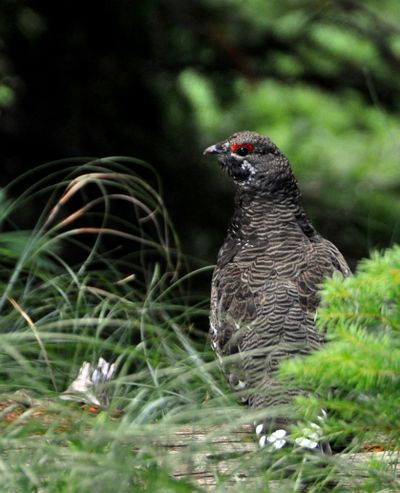Spruce grouse does it privately
Writer witnesses rarely seen forest grouse courtship

May was a mere seven hours old and a veil of fog hugged the ground. But even in the dim early light, it was clear spring had fully sprung in the North Woods.
This encounter occurred in Wisconsin, but it just as easily could have been in Montana, Idaho or the northern forests of Washington.
A trio of bull elk grazed, grabbing mouthfuls of new green growth. A bald eagle carried a northern pike back to its eaglets high in a tree south of the area.
And on the edge of a spruce bog miles from the nearest paved road, a rare bird was performing one of the least observed wildlife spectacles in the forest.
Dressed in handsome black-and-white plumage and sporting a brilliant red brow, the bird leaped from a branch and flew to an opening beneath the trees. Once on the ground, it postured and spread its fan, revealing the brown tips of its tail feathers.
The chicken-sized bird then walked 20 feet toward its previous perch and stopped to listen for sounds of a possible mate. After a few seconds, it flapped its wings and fluttered up to a limb 6 feet off the ground.
The bird – a male spruce grouse – repeated this sequence eight times over the next 20 minutes. Its goal? Attract a hen for breeding.
“It’s a sure sign of spring,” said Ryan Brady, leader of the outing and a wildlife biologist with the Wisconsin Department of Natural Resources. “But it’s one very few people ever get to see.”
The viewing rate is due to the species’ low population. The numbers are thin throughout the West, but even thinner in Wisconsin, where spruce grouse are listed as threatened species.
Also known as the “fool hen” for its lack of wariness toward humans, the bird’s preferred habitat is mostly spruce and larch bogs and associated conifer forests well off the beaten path. Compared with prairie grouse and even the ruffed grouse, the spruce grouse has a fairly secretive nature.
If you’re going to see one, there’s no better time than mid-April to mid-May, when male spruce grouse perform courtship displays.
And it helps immensely if you join the company of a wildlife expert such as Brady, one of the most skilled birders in the Midwest.
The first spruce grouse of the this day’s outing was elusive until Brady’s practiced ear detected a subtle flapping in a conifer stand to the east.
Prairie grouse, including sage and sharp-tailed grouse, gather in groups each spring to compete for mating rights. Their activity is almost as easy to spot as a neon sign.
The most common upland grouse species in country, the ruffed grouse, is well-known for its drumming display that can be heard for more than a mile.
Spruce grouse males establish a solo territory and attempt to draw a female with a relatively quiet repertoire of flutters, calls and displays.
An adult spruce grouse weighs about a pound, stands 16 inches tall and has a 22-inch wing span. The birds rely mostly on camouflage to escape predators. Spruce grouse eat conifer needles and various berries.
“It’s one of the treasures of the North Woods,” Brady said. “To protect it, we’ll have to protect the boreal forests.”